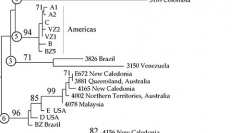

 Cryptogamie, Algologie
27 (3) - Pages 245-254
Cryptogamie, Algologie
27 (3) - Pages 245-254Red algae of the Bostrychia radicans / B. moritziana species complex are common in mangrove habitats. This group consists of seven highly divergent evolutionary lineages based on a plastid-encoded marker (RuBisCo spacer). We sampled this species complex around the island of New Caledonia. On the west coast of the island most samples were of Lineage 1 (four haplotypes), the most common lineage in the western Pacific Ocean. On the east coast of the island Lineage 1 samples were less common, with samples from lineages 2, 6, and 7, which have a world-wide distribution, predominating. Lineage 1 samples from the west coast had mostly an asexual reproductive life cycle (i.e. recycling tetrasporophytes) while the ones on the east coast were mostly sexual. A set of samples collected at a nickel ore port (Kouaoua, east coast), and found in Lineage 7 had a haplotype identical to a Florida USA sample. This study shows that biodiversity of algae can not solely be determined from morphological data. This study also highlights the differences in diversity between the east and west coasts of New Caledonia and suggests that historical, ecological and recent factors may have contributed to this difference.